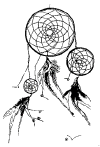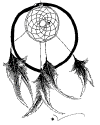CHAPTER XI.
TAKING OF MILLE LACS BY THE OJIBWAYS.
A, description of Mille Lacs, and its advantages as a home
for the Indian--It is occupied by the Dakotas in 1680--Traditions of the
Ojibways detailing the manner in which they, in turn, finally obtained
possession.Mille Lacs, the M' dé Wakan, or Spirit
Lake of the Dakotas,1 and the Missi-sag-i-egan or 'the lake that spreads all
over" of the Ojibways, is one of the largest and most beautiful sheets of
water in Minnesota Territory.2 it lies imbedded in deep forests, midway
between the Mississippi and the head of Lake Superior. Its picturesque
shores are skirted with immense groves of valuable sugar maple, and the soil
on which they grow is not to be surpassed in richness by any section of
country in the northwest. (Mille Lacs so called because it is the largest of
the numerous lakes, Mille Lacs (Thousand Lakes) of this region. Upon
Franqueltn's Map of 1688, it is called Buade, the family name of Count
Frontenac then governor of Canada, and Rum River its outlet is called
Rivière des François (French River) or Sioux River. Upon Hennepin's Map
Rivière des François is R. de St. Francis.--E. D. N.2 Written in A. D, 1852.
Minnesota in 1858 was admitted as one of the United States of America.--E.
D. N.)
The lake is nearly circular in form, though indented with
deep bays, and the view over its waters broken here and there by bold points
or promontories. It is about twenty miles across from shore to shore, and a
person standing on its pebbly beach on a clear, calm day, can but just
discern the blue outlines of the opposite side, especially as the country
surrounding it is comparatively low and level. Its waters are clear and pure
as the waters of Lake Superior, and fish of the finest species are found to
abound therein. Connected with it is a string of marshy, or mud-bottomed,
lakes in which the water is but a few feet deep, and wherein the wild rice
of the north grows luxuriantly, and in the greatest abundance.
Possessing these and other advantages, there is not a spot
in the northwest, which an Indian would sooner choose as a home and dwelling
place, than Mille Lacs. It is not then to be wondered at, that for nearly
two centuries, it has formed a bone of strife and contention between the
Ojibways and Dakotas.
The name of the still large and important band of Dakotas
known as the Mdé wakantons, has been derived from this lake; they now dwell
on the Mississippi and the lower portions of the Minnesota River. Their
ancestors were dwellers on Spirit Lake, and their bones have enriched the
soil about its shores. (The M'déwakantons (Spirit Lake People), in 1852 were
divided into seven bands, who dwelt on the western banks of the Mississippi
and in the lower Minnesota valley. The Ki-yuk-sa band lived below Lake
Pepin. Another band dwelt at Re-mni-ca (Hill, water and wood) now Red Wing,
a few miles above Lake Pepin. Kaposia band, four miles below St. Paul, Grey
Iron's band at Black Dog's village on the south bank of the Minnesota above
Mendota. Oak Grove band and Good Road's band on the upper bank of the
Minnesota, eight miles above Fort Snelling. Shokpedan, or Little Six, band
near the present town of Shakopee. In 1854 they were living on a reservation
in the valley of the upper Minnesota River. The Kaposia band was four miles
below the mouth of the Red Wood River, Shokpedan's band at the mouth of that
stream, while those of Wapatha and Waukouta were nearer the white
settlements, and remained here until after the massacre of 1862, when they
were removed to the Valley of the Missouri River.--E. D. N.)
I gather from "A sketch of the early trade and traders of
Minnesota," by the Rev. Edward D. Neill, of St. Paul, published in the
Annals of the Minnesota Historical Society for 1852, that in the year 1680,
the Franciscan priest Hennepin, with two companions named Michael Ako2 and
Picard du Gay, were taken captive by the Dakotas of Mille Also spelled
Accault. La Salle writes that Ako was the leader of the party.--E. D. N.
Lacs. This fact is mentioned here to show that at this date, this tribe
still held possession, and resided on or near this lake. It is further
stated that through the influence of the early French traders who first
built posts in their country, among whom may be mentioned as most
conspicuous the names of Nicholas Perrot and Le Sueur, "the Dakotas began to
be led away from the rice grounds of the Mille Lacs region."
Tradition among the Ojibways says otherwise. They deny
that the influence of the traders could induce the Mdewakantons to evacuate
such a desirable point in their country as Mille Lacs, a spot covered with
their permanent earthen wigwams, and the resting place of their forefathers.
The early French explorers only mention wigwams of bark or skins.--E. D. N.
Our own experience of the great love and attachment, which
the red race has ever shown to their ancient village sites, wouldcause us to
doubt this assertion on the part of the Dakotas. It is sooner to be believed
that the same force which has caused them to relinquish, step by step, all
their former country east of the Mississippi during the course of the past
two or three centuries, operated to drive them from this, their strongest
hold of olden times.
The manner in which the Ojibways first came into
possession of Mille Lacs, is vividly related by their old men, and this
event forms a prominent item in the course of their past history. The
tradition of this occurrence is briefly as follows, taken by the writer from
the lips of one of their most truth-telling sages, who is now a resident of
Mille Lacs, and who is the descendant of a long line of noted chiefs.
TRADITION OF THE TAKING OF MILLE LACS BY THE OJIBWAYS
Five generations ago, shortly after the Ojibways residing
on the shores of Lake Superior had commenced to obtain fire-arms and
ammunition of the old French traders, a firm peace existed between them and
the Dakotas, who then resided on the head waters of the Mississippi and the
midland country which lay between this river and the Great Lake.
Good will existed between the two tribes, and the roads to
their villages were clear and unobstructed. Peace-parties of the Dakotas
visited the wigwams of the Ojibways, and the Ojibways, in like manner,
visited the Tepees and earthen lodges of the Dakotas. The good feeling
existing between them was such, that intermarriages even took place between
them.
It appears, however, impossible, that these two powerful
tribes should ever remain long in peace with each other. On this occasion
the war-club had lain buried but a few winters, when it was again violently
dug up, and the ancient feud raged more fiercely than ever.
Ill will was first created in the breasts of the two
tribes against one another, through a quarrel, which happened between an
Ojibway and a Dakota gallant, respecting a woman whom they both courted. The
woman was a Dakota, and the affair took place at a village of her people. Of
her two suitors she preferred the Ojibway, and the rejected gallant, in
revenge, took the life of his successful rival. This act, however, did not
result in immediate hostilities; it only reminded the warriors of the two
tribes that they had once been enemies; it required a more aggravating cause
than this to break the ties which several years of good understanding and
social intercourse had created between them, and this cause was not long in
forthcoming.
There was an old man residing at Fond du Lac of Lake
Superior, which place had at this time, already become an important village
of the Ojibways. This old man was looked upon by his people with much
respect and consideration: though not a chief, he was a great hunter, and
his lodge ever abounded in plenty. He belonged to the Marten Totem family.
He was blessed with four sons, all of whom were full grown and likely men,
"fair to look upon." They were accustomed to make frequent visits to the
villages of the Dakotas, and they generally returned laden with presents,
for the young women of their tribe looked on them with wishful and longing
eyes.
Shortly after the quarrel about the woman had taken place,
which resulted in the death of an Ojibway, the four brothers paid the
Dakotas one of their usual peaceful visits; they proceeded to their great
town at Mille Lac, which was but two days from their own villages. During
this visit, one of the brothers was treacherously murdered, and but three
returned with safety to their father's wigwam.
The old man did not, even complain when he heard that
their former enemies had sent his son to travel on the Spirit road; and
shortly after, when his three surviving sons asked his permission to go
again to enter the lodges of the Dakotas, he told them to go, "for
probably," said he, "they have taken the life of my son through mistake."
The brothers proceeded as before to Mille Lac, and on this occasion, two of
them were again treacherously killed, and but one returned to the wigwam of
his bereaved father; The fount of the old man's tears still did not open,
though he blacked his face in mourning, and his head hung down in sorrow.
Once more his sole surviving son requested to pay the
Dakotas a peace visit, which he might look on the graves of his deceased
brethren. His sorrow stricken parent said to him, "Go, my son, for probably
they have struck your brothers through mistake." Day after day rolled over,
till the time came when he had promised to return. The days, however, kept
rolling on, and the young man returned not to cheer the lonely lodge of his
father. A full moon passed over, and still he made not his appearance, and
the old man became convinced that the Dakotas had sent him to join his
murdered brethren in the land of Spirits. Now, for the first time, the
bereaved father began to weep, the fount of his tears welled forth-bitter
drops, andhe mourned bitterly for his lost children.
"An Ojibway warrior never throws away his tears," and the
old man determined to have revenge. For two years he busied himself in
making preparations. With the fruits of his hunts he procured ammunition and
other materials for a war party. He sent his tobacco and war-club to the
remotest villages of his people, detailing his wrong and inviting them to
collect by a certain day at Fond du Lac, to go with him in "search for his
lost children." His summons was promptly and numerously obeyed, and nearly
all the men of his tribe residing on the shores of the Great Lake, collected
by the appointed time at Fond du Lac. Their scalping knives had long rusted
in disuse, and the warriors were eager once more to stain them with the
blood of their old enemy.
Having made the customary preparations, and invoked the
Great Spirit to their aid, this large war party which the old man had
collected, left Fond du Lac, and followed the trail towards Mille Lac, which
was then considered the strongest hold of their enemies, and where the blood
which they went to revenge had been spilt. The Dakotas occupied the lake in
two large villages, one being located on Cormorant point, and the other at
the outlet of the lake. A few miles below this last village, they possessed
another considerable village on a smaller lake, connected with Mille Lac by
a portion of Rum River, which run through it. These villages consisted
mostly of earthen wigwams such as are found still to be in use among the
Arickarees and other tribes residing on the Upper Missouri.
The vanguard of the Ojibways fell on the Dakotas at
Cormorant point early in the morning, and such was the extent of the war
party, that before the rear had arrived, the battle at this point had
already ended by the almost total extermination of its inhabitants; a small
remnant only, retired in their canoes to the greater village located at the
entry. This, the Ojibways attacked with all their forces; after a brave
defense with their bows and barbed arrows, the Dakotas took refuge in their
earthen lodges from the more deadly weapons of their enemy.
The only manner by which the Ojibways could harass and
dislodge them from these otherwise secure retreats, was to throw small
bundles or bags of powder into the aperture made in the top of each, both
for the purpose of giving light within, and emitting the smoke of the wigwam
fire. The bundles ignited by the fire, spread death anddismay amongst the
miserable beings who crowded within. Not having as yet, like the more
fortunate Ojibways, been blessed with the presence of white traders, the
Dakotas were still ignorant of the nature of gunpowder, and the idea
possessing their minds that their enemies were aided by spirits, they gave
up the fight in despair and were easily dispatched. But a remnant retired
during the darkness of night to their last remaining village on the smaller
lake. Here they made their last stand, and the Ojibways following them up,
the havoc among their ranks was continued during the whole course of another
day.
The next morning the Ojibways wishing to renew the
conflict, found the village evacuated by the few who had survived their
victorious arms. They had fled during the night down the river in their
canoes, and it became a common saying that the former dwellers of Mille Lacs
became, by this three days' struggle, swept away for ever from their
favorite village sites. The remains of their earthen wigwams are still
plainly visible in great numbers on the spots where these events are said to
have occurred; they are now mostly covered by forests of maple trees. The
Ojibways assert as a proof of this tradition, that whenever they have dug
into these mounds, which they occasionally do, they have discovered human
bones in great abundance and lying scattered promiscuously in the soil,
showing that they had not been regularly buried, but were cut in pieces and
scattered about, as Indians always treat those they slay in battle.
It is as well to state here, that some of the old men who
relate this tradition, give the name of O-maum-ee to the former dwellers of
Mille Lacs, and they further assert that these people were totally
exterminated on this occasion. The more intelligent affirm that they were
the Ab-oin or Dakotas, who having their principal village on a peninsula, or
Min-a-waum, were known in those days by the name of O-maum-ee. This,
connected with the fact afforded us by the early French explorers, Hennepin,
Du Luth and Le Sueur, that the Mdé wakantons were former dwellers of Mille
Lacs, is sufficient to prove the identity of the people whom the Ojibways
drove from its possession.
Ojibway tradition further states that the Dakotas who had
been driven from Mille Lacs, made another village on Rum River, and that
they did not finally leave this region of country till about the year 1770,
after their great expedition or war party to the head-waters of the
Mississippi, which resulted in the battle of Crow Wing, as will be related
in a future chapter.The Mdé wakanton Sioux used to assert that about the
year 1780, they lived in one village, on the banks of the Minnesota, a short
distance above Mendota.
go to
chapter 12
1
- 2
- 3
- 4
- 5
- 6
- 7
- 8
- 9
- 10
11
- 12
- 13
- 14
- 15
- 16
- 17
- 18
- 19
- 20
21
- 22
- 23
- 24
- 25 - 26 - 27 - 28 - 29 - 30
History of the Ojibways (Part 2 of Many)
White Eagle Soaring: Dream Dancer of the 7th Fire







 Get
a course to promote your business online, explode your sales
Get
a course to promote your business online, explode your sales Get
software to promote your business online in less time
Get
software to promote your business online in less time Get
software to streamline your business and run it hands free.
Get
software to streamline your business and run it hands free.